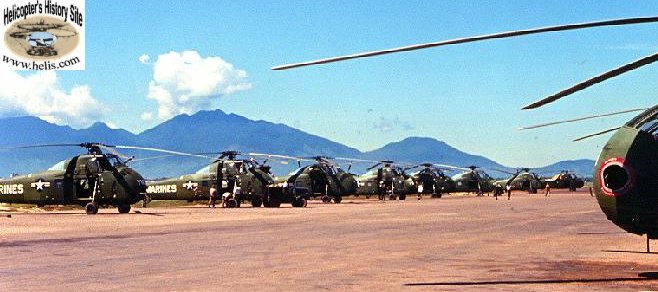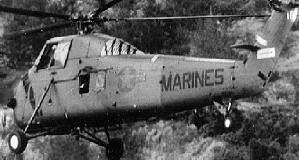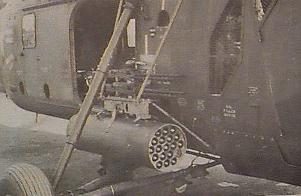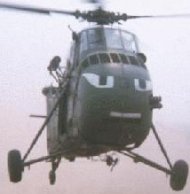The Sikorsky S-58 was first developed as an anti submarine helicopter for the US Navy
in the 1950s as the HSS-1 Sea Bat
( with the US Department of Defense normalization of 1962 received the SH-34 core designation )
and like all other good helicopters was soon adapted to several missions.
The US Army also operated them as CH-34 and HH-34 Choctaw for cargo
and rescue missions and the variant of the US Marines were known as the HUS-1 ( later UH-34 ) Sea Horse.

The Sea Horse primary role was personnel and cargo transport. The aircraft were "slick" meaning that they had no weapons but by August 1962, M-60 machine guns were mounted inside the aircraft. Two machine guns were utilized: one for the crew chief, mounted at the main door and one mounted in the rear window on the opposite side for use of the gunner. Very often the pilot and co-pilot carried an AR15, which was the forerunner of today 's M16 rifle, next to their seat in the cockpit which allowed them to provide fire support if they were not on the controls.
The US Army, with a small unit deployed in Da Nang, had Bell UH-1B ( at that time known as HU-1B ) aircraft configured as gunships and would serve as escorts when there own commitments allowed. UH-1B aircraft for Marine use was still in the future; the UH-1E specialized Marines version of the Huey arrived in 1966.

All these reasons, along with the limited amount of aircraft the army had, resulted in the Marine Corps Development Center at Quantico experimenting with some method of providing the Marine Corps a means of escorting themselves. The method decided on was to arm the UH-34.
UH-34s' were modified by mounting two fixed, forward firing M-60 machine guns attached to the landing gear on the right side and two 2.75" FFAR ( Folding Fin Aerial Rocket ) pods attached between the landing gear struts on each side of the aircraft.

Many problems plagued the conversion and perhaps the mounting design was the major of them. With the rigid mounts, neither the machine guns nor the rockets could be aimed without the entire helicopter being pointed in the direction of the target. This made for some pretty unusual flying altitudes trying to line up the cross-hair with the dot by pointing the aircraft....and by the way...while, usually, presenting a pretty big bulls-eye for the target.

See also:
 Hueys in Vietnam
Hueys in Vietnam
 Database: Sikorsky S-58 in USMC
Database: Sikorsky S-58 in USMC
 Database: Bell UH-1E in USMC
Database: Bell UH-1E in USMC
On April 15, 1962 Operation Shufly was initiated when the HMM-362 (
US Marines Medium Helicopter Squadron 362 ) landed at a Japanese fighter strip
3 miles from Soc Trang, southwest of Saigon, in the Mekong Delta in the
Republic of South Viet Nam.
This was four months after the first american helicopters arrived.
Operation Shufly was set up as a multi-squadron rotation exercise. The plan was for a squadron to be deployed on a four-month rotation with four months in Okinawa ( Japan ), four months aboard ship, and four months in Viet Nam. Only the personnel were transferred: they received what equipment was already at the base.
Operation Shufly was set up as a multi-squadron rotation exercise. The plan was for a squadron to be deployed on a four-month rotation with four months in Okinawa ( Japan ), four months aboard ship, and four months in Viet Nam. Only the personnel were transferred: they received what equipment was already at the base.

The Sea Horse primary role was personnel and cargo transport. The aircraft were "slick" meaning that they had no weapons but by August 1962, M-60 machine guns were mounted inside the aircraft. Two machine guns were utilized: one for the crew chief, mounted at the main door and one mounted in the rear window on the opposite side for use of the gunner. Very often the pilot and co-pilot carried an AR15, which was the forerunner of today 's M16 rifle, next to their seat in the cockpit which allowed them to provide fire support if they were not on the controls.
The US Army, with a small unit deployed in Da Nang, had Bell UH-1B ( at that time known as HU-1B ) aircraft configured as gunships and would serve as escorts when there own commitments allowed. UH-1B aircraft for Marine use was still in the future; the UH-1E specialized Marines version of the Huey arrived in 1966.
The army UH-1B was a little underpowered for the role they were playing and must be remembered,
was also an experiment for the US Army .
The extra weight of several boxes of ammunition and the extra crew members to maintain a constant
flow of ammunition and manning extra M-60 machine guns caused the UH-1B to be slow and
with limited range. This was because of the need to cut back on the amount of fuel
carried to allow for the extra weight. A strike of any distance would require a refueling stop
for the UH-1B along the route while the UH-34 circled.

All these reasons, along with the limited amount of aircraft the army had, resulted in the Marine Corps Development Center at Quantico experimenting with some method of providing the Marine Corps a means of escorting themselves. The method decided on was to arm the UH-34.
UH-34s' were modified by mounting two fixed, forward firing M-60 machine guns attached to the landing gear on the right side and two 2.75" FFAR ( Folding Fin Aerial Rocket ) pods attached between the landing gear struts on each side of the aircraft.
Both rear windows now had an M-60 machine gun installed and one in the door for the crew chief. The rockets' sighting system was very primitive but useable. It consisted of a grease pencil mark on the windshield and a cross hair welded inside a circle mounted to the instrument panel and windshield with nuts and bolts. The system required the cross hair in the circle be lined up with the grease pencil and the target. What it lacked in sophistication, it made up in reliability.
Pilots that flew them began to hit targets consistently, after a little practice.
The armed H-34s, called Stingers had only four aircraft modified. They were all assigned to HMM-365 commanded by Lt.Col. Joseph Koler and was the only Marine helicopter unit to utilize a piston powered helicopter as a gunship.
The armed H-34s, called Stingers had only four aircraft modified. They were all assigned to HMM-365 commanded by Lt.Col. Joseph Koler and was the only Marine helicopter unit to utilize a piston powered helicopter as a gunship.

Many problems plagued the conversion and perhaps the mounting design was the major of them. With the rigid mounts, neither the machine guns nor the rockets could be aimed without the entire helicopter being pointed in the direction of the target. This made for some pretty unusual flying altitudes trying to line up the cross-hair with the dot by pointing the aircraft....and by the way...while, usually, presenting a pretty big bulls-eye for the target.
The UH-34 was a relatively large, slow aircraft and the target usually got some pretty good shots at the gunship. All these factors contributed to an unusually number of Stingers damaged by ground fire. The US Army solved this problem in later versions of the UH-1B by mounting their armament on swivels that could be aimed in a direction other than the one the aircraft was pointed.
In spite of all the limitations, the US Marines used the Stingers effectively and extensively but the days of piston powered aircraft were numbered and the decision was made to discontinue the experiment. Turbine powered aircraft was the future of helicopter warfare. As soon as the US Army got some more armed UH-1Bs to Da Nang to support the marines increased flight operations, the Stingers were striped of their forward firing armament returning to a transport configuration and became but a footnote in history.
In spite of all the limitations, the US Marines used the Stingers effectively and extensively but the days of piston powered aircraft were numbered and the decision was made to discontinue the experiment. Turbine powered aircraft was the future of helicopter warfare. As soon as the US Army got some more armed UH-1Bs to Da Nang to support the marines increased flight operations, the Stingers were striped of their forward firing armament returning to a transport configuration and became but a footnote in history.

See also:
| User Contributed Notes | ||
| Add note to this page |
